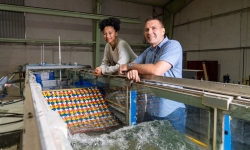Mentored to become a master – port and coastal engineer student making waves at the CSIR
She has become a familiar figure against the brick and mortar backdrop of the CSIR Hydraulic Laboratory in Stellenbosch – just as familiar and consistent as the waves that she has been generating day in and day out as part of her Master’s degree research. Meet Melissa Cairns, a full-time student at Stellenbosch University, where she first completed her Bachelor of Engineering in civil engineering during 2020.
She has become a familiar figure against the brick and mortar backdrop of the CSIR Hydraulic Laboratory in Stellenbosch – just as familiar and consistent as the waves that she has been generating day in and day out as part of her Master’s degree research. Meet Melissa Cairns, a full-time student at Stellenbosch University, where she first completed her Bachelor of Engineering in civil engineering during 2020. Since then, Cairns has been working towards her Master’s degree in port and coastal engineering at the university’s Faculty of Engineering.
Cairns’s affiliation with the CSIR is two-fold. “I have worked with the CSIR through the company I work for, PRDW Consulting – Port and Coastal Engineers. PRDW is an international group practicing exclusively in the area of port and coastal engineering. PRDW regularly works with Stellenbosch University and the CSIR.”
The collaboration between a leading multidisciplinary research institute and a leading research university provides fruitful possibilities for aspirant students. Add to the mix a highly specialised company committed to embracing equality and the empowerment of women, the young professional finds herself in a covetous set of academic and professional circumstances.
“The CSIR allows engineering students, like myself, to access its hydraulic laboratory for model testing,” she says. The admission to the world-class facility is critical for the theoretical research component of her thesis.
“I am researching a new concrete armour unit shape called the Cubilok™, which my company is developing. I am modelling a section of a breakwater, which is a barrier built in the sea to protect a coast or a harbour from the forces of waves, using the Cubilok units. So far, I have enjoyed observing how the waves interact with the structure. I am excited about the potential development of the armour unit and knowing I would have had a small role in its development. My research will help determine the stability of the armoured unit, as well as the allowable overtopping limit, in other words, the amount of water that spills over the crest of coast structures. The wave interaction is modelled using a scaled replica of a typical cross-section of a rubble-mound breakwater.
Enters mentor and co-supervisor, Carl Wehlitz
CSIR port and coastal engineer, Wehlitz, is co-supervising Cairns’ research and provides mentorship through his extensive experience in coastal engineering and port infrastructure. Carl has conducted numerous two- (2D) and three-dimensional physical model studies for local and international clients.
Currently he is managing the physical modelling facilities at the CSIR and enjoys transferring the knowledge that he has gained over the years to the next generation of engineers. This aligns with the CSIR’s recognition that mentorship contributes to the development of leadership capabilities at all levels. He explains, “I take part in multiple student programmes at Stellenbosch University, however, mentoring the postgraduates is by far the most rewarding. It is not just about conveying the knowledge related to port and coastal engineering, but in most cases, creating new knowledge and insight as well. Leaving a constructive impression on our future generations is the legacy that I would like to leave behind.”
“I would say the most important aspect of the mentorship Carl has provided has been the insight he gives. Carl has considerable experience in this particular subject area, having himself undertaken research on the original Cubilok™ unit, which formed part of his Master’s degree in 2020.”
Engineering an empowered future
“So far, I enjoy the challenge that engineering provides. The engineering solutions or prevention strategies keep me engaged and excited. I enjoy learning and engineering forces you to be a lifelong learner,” she says.
Cairns is positively ambitious about her future as an aspirant port and coastal engineer and has her goals set high. “I am keen to obtain professional working experience in the field of port and coastal engineering, and hopefully work abroad to further expand my skill set.”

in front of the glass panel wave flume where Melissa is currently
undertaking her research for her Master’s degree



